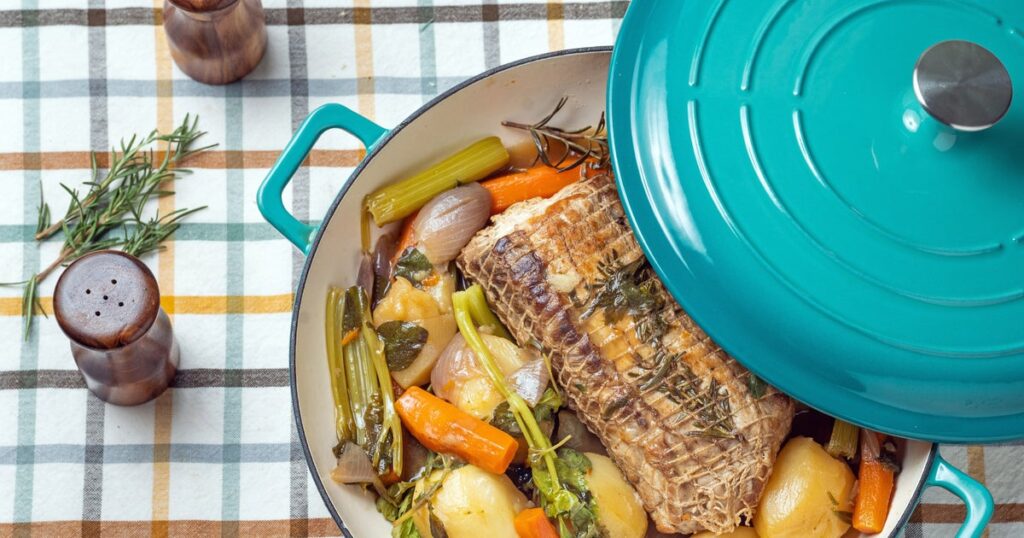For many home cooks, a high-quality enameled Dutch oven represents one of the most valuable and serious cookware investments. Elite brands like Le Creuset and Staub sell Dutch ovens for hundreds of dollars each, and part of what justifies the high price tag is the assumption that these artisanally crafted pieces can last a lifetime (and beyond). So when you spot a scratch (or even a chip) on the enamel of your Le Creuset, it can send you into a not-so-minor tailspin.
But how disastrous are enamel scratches really? Is it still safe to use a scuffed Dutch oven, or is your beloved pot now doomed for the dumpster? We asked a group of professional chefs and food safety experts to break down the potential health consequences of using a scratched Dutch oven, when a scratch needs to be taken seriously, and whether it’s possible to bring a badly worn Dutch oven back to life. Here’s what they had to say.
A deeply scratched Dutch oven can cause food contamination.
First of all, we asked the experts to explain why exactly a scratch or a chip on an enameled Dutch oven can prove dangerous.
“Enameled cast iron that is chipped can present a physical hazard because the enamel coating is essentially glass that is fused to the iron,” said Bryan Quoc Le, a food scientist and food industry consultant for Mendocino Food Consulting. So if bits of enamel are coming off and landing in your food, you’re essentially eating glass, which can lacerate your mouth, throat, esophagus, stomach and/or intestines.
Melissa Vaccaro, a food safety expert at the National Environmental Health Association (NEHA), added that “if the enamel coating is chipped or cracked, exposing the cast iron underneath, food can come into contact with bare metal, leading to rust and metal leaching.” Rust is made of iron oxide, which isn’t easily absorbed into the body and is not considered food-safe by the USDA.
If your Dutch oven is a vintage version inherited from a parent or grandparent, Vaccaro pointed out another important consideration: “Some older or low-quality enamel coatings may contain lead or cadmium (modern reputable brands like Le Creuset or Staub do not), [and] if the enamel flakes off, there’s a potential risk of ingesting [these] hazardous substances.” Lead and cadmium poisoning can lead to high blood pressure, cardiovascular problems, kidney damage, stomach irritation and pregnancy complications.
A Dutch oven with light, superficial scratches is still safe to use.
While serious scratches and enamel chipping are bad news for Dutch oven users, we’re happy to report that light scratches and scuffs on the exterior and interior won’t negatively impact your health or the quality of your food.
“Minor, superficial scratches in the enamel (that don’t expose the metal underneath) are typically cosmetic and not a health hazard. Scratches that don’t penetrate the enamel layer are safe for cooking and occur naturally over time,” Vaccaro assured us.
But while light scrapes and scratches aren’t an inherent problem, Vaccaro and other experts recommend keeping a close eye on these marks and tracking their progress. According to Vaccaro, it’s time to worry when “you feel rough edges, see bare metal, [or see that] the enamel is peeling off.” In these cases, “if the damage is in an area that comes into direct contact with food or liquids,” the Dutch oven can pose the health risks that we detailed earlier.
Once a Dutch oven has deep scratches or enamel chips, it can’t be rehabbed.
Imagine that the worst-case scenario has come to pass: Your much-loved Dutch oven has a big, deep, metal-exposing scratch or a visible enamel chip. What’s the next course of action? Is there a way to repair this pricey piece of cooking equipment, either at home or by a professional artisan?
billnoll via Getty Images
Unfortunately, the answer to this question is generally “no.” “Re-glazing at home isn’t an option. Those enamels are fired at over 1,400°F in a kiln and need industrial-grade equipment,” pointed out Chris Van Dyne, head chef at Cosmic Pie Pizza in Santa Fe, New Mexico.
If you’re hoping that you might be able to take your chipped Le Creuset to a ceramic repair shop, you’re about to be further disappointed. “The enamel is a coating applied once at production through a special process, and is intended to be a permanent, continuous layer, so there is no way to rehabilitate it once damage has occurred. Even sanding down the spots to smooth out the scratches and chips won’t help, and may even accelerate future breakdown of the enamel, due to the weakened structure,” Le told us. And while a bare cast-iron skillet can be scraped down and re-seasoned, “you cannot re-season or patch enamel,” Vaccaro said.
If your Dutch oven comes from one of the more reputable and high-end brands like Le Creuset and Staub, Van Dyne recommended “checking their warranty. They often replace chipped units for free or at a discount, even years later.”
But if you can’t trade in your chipped Dutch oven for a replacement, there are other ways to make use of these colorful pots. Clever DIY-ers on YouTube, TikTok and Pinterest have repurposed their Dutch ovens as planters, storage vessels for home goods, ice buckets, bird baths, humidifiers, and much more. Do some searching on those platforms and see what you can find.
To keep your Dutch oven as unmarred and usable as possible, be gentle with your washing process.
Now that we’ve established the risks associated with chipped and deeply scratched Dutch ovens, you’re likely wondering how you can avoid such a grievous fate for your own enameled pot. Luckily, Melissa Araujo, chef/owner of Alma Cafe in New Orleans, offered us some helpful pointers for keeping a Dutch oven in top shape.
“Make sure that [the Dutch oven] is cool before you wash it, and make sure you use non-scratch sponges, [as] anything abrasive will scratch it.” Araujo also warned against “soaking it in the sink for a long time. [That] will allow water to seep under the coating, and you run the risk of rusting the outer rims.” Speaking of rust, it’s important to “dry the Dutch oven completely so it doesn’t rust.”
Should you find yourself with a particularly nasty stain from cooking in your Dutch oven, Araujo recommended mixing “baking soda and water and putting it on [the stain] for about 10 minutes.” You can then rinse the pot and wash with a soft sponge and gentle dish soap, and if the stain still lingers, repeat the baking soda mixture and handwashing process.
Whatever you do, don’t even think about “putting the Dutch oven in the dishwasher, even if it says ‘dishwasher safe.’ Constant water [pressure] and high heat are bad for the coating.”
Finally, when it comes to storing the Dutch oven (whether you keep it in a cabinet, on a shelf, or on your stovetop), “put a towel inside to keep it protected. I also store it with the lid slightly moved so there’s air flow that moves in and out,” Araujo said.
Read the full article here








